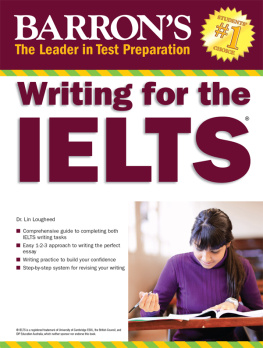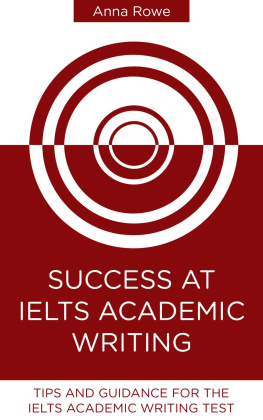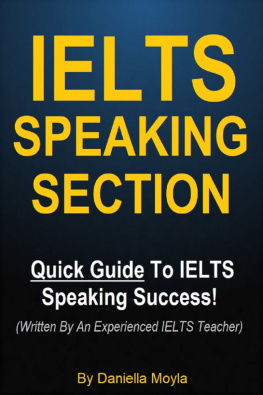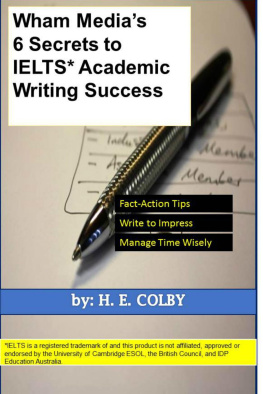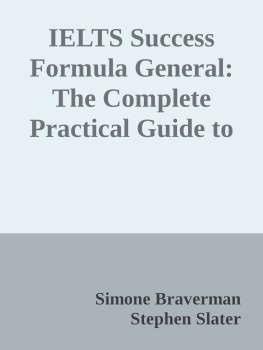IELTS WritingSection
(Academic)
How To AchieveA Target 8 Score!
By TimDickeson
Copyright by Tim Dickeson 2014
Published by Sanbrook Publishing
Smashwords Edition
Limits ofLiability / Disclaimer of Warranty:
The authorand publisher of this book and the accompanying materials have usedtheir best efforts in preparing this program. The author andpublisher make no representation or warranties with respect to theaccuracy, applicability, fitness, or completeness of the contentsof this program. They disclaim any warranties (expressed orimplied), merchantability, or fitness for any particular purpose.The author and publisher shall in no event be held liable for anyloss or other damage, including but not limited to special,incidental, consequential, or other damages. As always, the adviceof a competent legal, tax, accounting or other professionals shouldbe sought.
This manualcontains material protected under International and FederalCopyright Laws and Treaties. Any unauthorized reprint or use ofthis material is prohibited.
IELTS isjointly owned by British Council, IDP: IELTS Australia and theUniversity of Cambridge ESOL Examinations (CambridgeESOL).
ISBN:9781311830630
*****
Table ofContents
Who This Book Is For
This book is for anyone who isabout to take the IELTS exam and wants direct instructions for howto write high scoring answers in the IELTS writing section(Academic test mode).
This material is perfect foryou if:
You didntobtain the score you wanted in the writing section
You dontknow how to identify the possible question types you couldreceive
You dontknow how to develop the correct structures for the differentquestion types
You dontknow how to formulate a high scoring report (Task 1)
You dontknow how to write a high scoring introduction (Task 2)
You dontknow how to write high scoring middle (supporting) paragraphs (Task2)
You dontknow how to write a high scoring conclusion (Task 2)
You havebought other IELTS preparation material but you found themconfusing
Your IELTSexam is very soon and you want direct strategies to use
Module 1 IELTS Outline
WhatIs The IELTS?
The IELTS (InternationalEnglish Language Testing System) is a test that evaluates theEnglish proficiency of people with English as a second language whowould like to work or study where English is used as the primarycommunication language (usually in English speaking countries).
The IELTS test measures Englishproficiency covering: listening, reading, writing and speaking, anduses a 9-band scale to indicate proficiency level.
IELTS is required for peoplewho want to study at secondary and tertiary level and for theapplication of visas and employment.
TheTwo Test Modes (Academic / General Training)
IELTS provides two types oftest modes and the type of test mode that you will need to takewill depend on your circumstances. The two test modes are; Academicand General Training. Lets look at the difference between the twotest modes.
Academic Evaluates English languagecompetency for academic and tertiary purposes.
For example University,TAFE
GeneralTraining Evaluates English languagecompetency in a practical, living context.
For example Employment,Visas
Note: The Academic and General Training test modes aregraded using the same criteria for the writing section of theIELTS.
Scoring Structure How IELTS Will ScoreYou
Your IELTS score will be givenbetween 0 9 for each of the four sections and then an overallscore given between 0 9.
Below shows the scoring rangefor each section and the overall score.
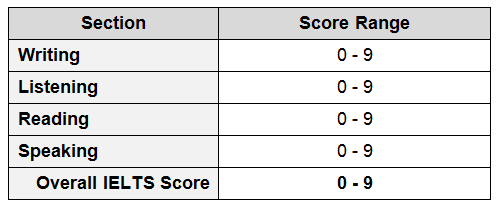
The score bands as shown belowoutline the competency of the student and the scores are given in0.5 point increments.
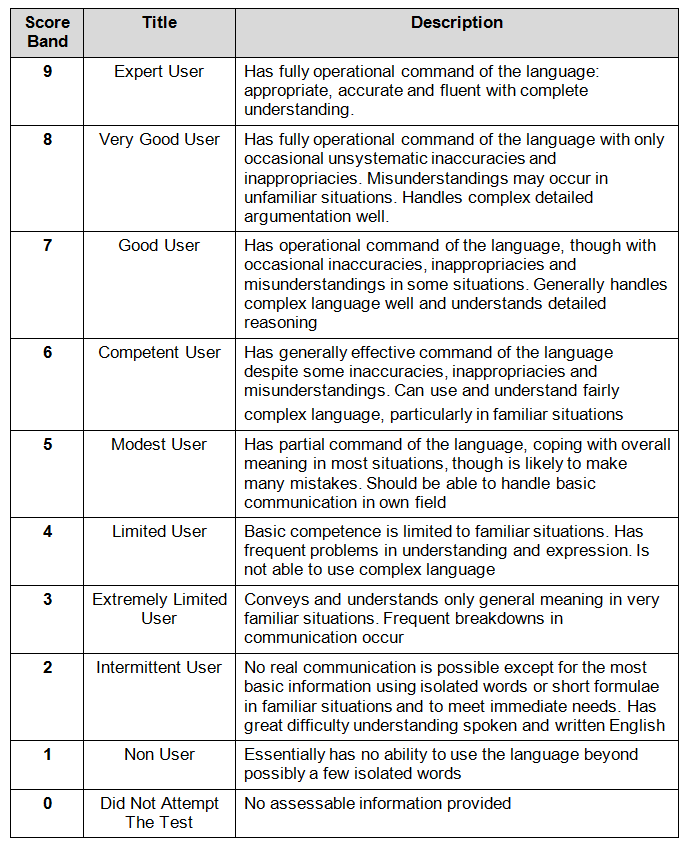
Module 2 IELTS Writing Section Overview
What Is The Writing Section?
The Writing section is animportant section because there are only two parts to this sectionso there is less room for error.
The Writing section of theIELTS tests your ability to write effectively in the form ofwell-structured answers with correct sentence structure, grammar,spelling and vocabulary.
What IsThe Answer Format?
There aretwo writing tasks and BOTH must be completed within the 60 minutetime limit.
Answers mustbe given on the answer sheet and must be written infull.
Notes orbullet points in whole or part are not acceptable asanswers.
Timing
60 minutesfor both sections.
Marks
The twotasks are scored independently, however Task 2 is worth double themarks of Task 1.
Writing Section DifferenceBetween The Two Test Modes
The maindifference lies in the content/topic of what the questions asks youto write about. The GeneralTraining mode requires more simple styledwriting associated with personal ideas. However the Academic mode requiresmore formal and descriptive answers.
The table below outlines therequirements for both test modes:
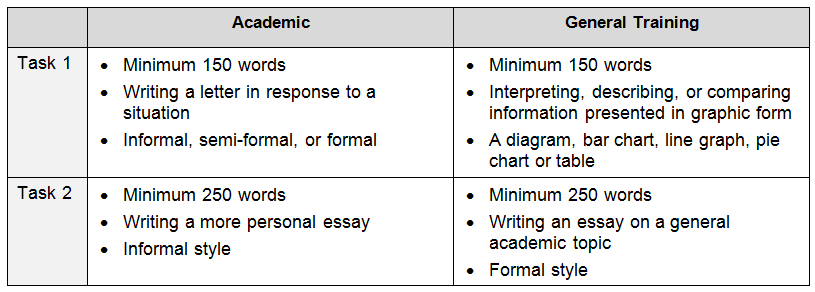
Writing Section General TrainingTest Mode
The General Training writingsection measures your ability to communicate about common,practical issues and expand on topics of personal interest. You maybe asked to provide factual information, express likes anddislikes, make suggestions or present complaints, opinions orviews.
Task 1 150words 20 minutes
Task 2 250words 40 minutes
Writing Section Academic Test Mode
The Academic writing sectionmeasures your ability to write in clear, formal English used in anacademic context.
Task 1 150words 20 minutes
Task 2 250words 40 minutes
Module 3 Writing Task 1
Unit 1 Writing Task 1 Introduction
Objective ofthis Unit : To understand what writing task1 is.
What Is The Writing Task 1?
For writing task 1 you arerequired to write a short report on graphical information provided.This means you may be asked to describe a diagram, chart or graph,or some other graphic representation. You may also be asked todescribe the process illustrated by a diagram.
Tip: The best way to think of this report is toimagine you are writing a report for somebody who cannot see theinformation, so they can understand what is happening.
Tip: Make sure your report is neutral and unbiased.This means that your opinion should NOT be included in yourreport.
Why Do Many People Find Task 1Difficult?
This task is difficult for manypeople because they are not sure what things to write about and howto actually describe what is happening in the way that the IELTSevaluators want.
Once you know how to structureyour answer and the way to express the information correctly anddevelop your answer in the way the evaluators love, it becomes veryeasy.
This book will show you exactlyhow to do this.
Unit 2 Developing A System For Your Report
Objective ofthis Unit : To develop a system foranswering writing task 1.
Writing System Creation
The most efficient way ofapproaching the writing section and the individual tasks is byimplementing a systemized approach. A system reduces time wastingand makes sure you are answering the questions in the best waypossible.
Next page


